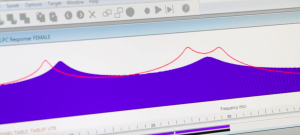For my project, I have been working on conducting a research study investigating the effects of auditory perception on a person’s speech or their ability to learn and perform a speech-motor task using alternative speech therapy techniques, including biofeedback technology.
 example of computer-based biofeedback in which participants must match their speech production (represented by the blue wave) with the visual target (represented by the red line)
example of computer-based biofeedback in which participants must match their speech production (represented by the blue wave) with the visual target (represented by the red line)
The following is a general outline of the protocol:
- Baseline: record trials of participant speaking “head” and “had”
- Perceptual Task 1: measure participants’ perceptual boundary between “head” and “had” using 11-step continuum (listen below)
- Perceptual Task 2 and 3: shift participants’ perceptual boundary one step towards “had” (group A) or one step towards “head” (group B)
- Speech-Motor Task: record participants speaking “head” while trying to reach a visual target (half-way in-between “head” and “had”) using biofeedback
If my hypothesis is correct, group A (boundary shifted towards “had”) should perform better on the speech-motor task than group B (shifted towards “head”). Both groups are asked to produce the word “head” and reach a visual target, using biofeedback, that is half-way in-between “head” and “had” (step 6 in the images below). Group A (after perceptual training) perceives this point on the continuum to be the word “head”, in concordance with the word they are producing. Conversely, group B perceives this point as the word “had” and should have a harder time reaching the target due to the disparity between the word they are being asked to produce (“head”) and the target (what they perceive to be “had”).
For the past month, my advisor and I have been working out the details of this intricate protocol by running several pilot sessions and collaborating with other established researchers in the field of perception and speech. This is important because every aspect of the protocol can ultimately affect the accuracy and significance of the results. For example, there needs to be enough trials in the speech-motor task to ensure a significant learning trend, yet too many trials could lead to a fatigue effect. Moreover, we have been working with programmers in order to create the necessary codes and computer programs to perform and analyze the results of the perceptual tasks. Ideally, we will start recruiting actual participants later this week or next and start collecting data as soon as possible.



